Kartoffelklöße (German Potato Dumplings)
This post may contain affiliate links. See my disclosure policy.
An authentic German Potato Dumplings recipe (Kartoffelklöße Rezept), just the way my Mutti and Oma always made them! Pillowy soft and tender, they are the perfect accompaniment to your sauce-based dishes and do a magnificent job of mopping up all that delicious gravy!
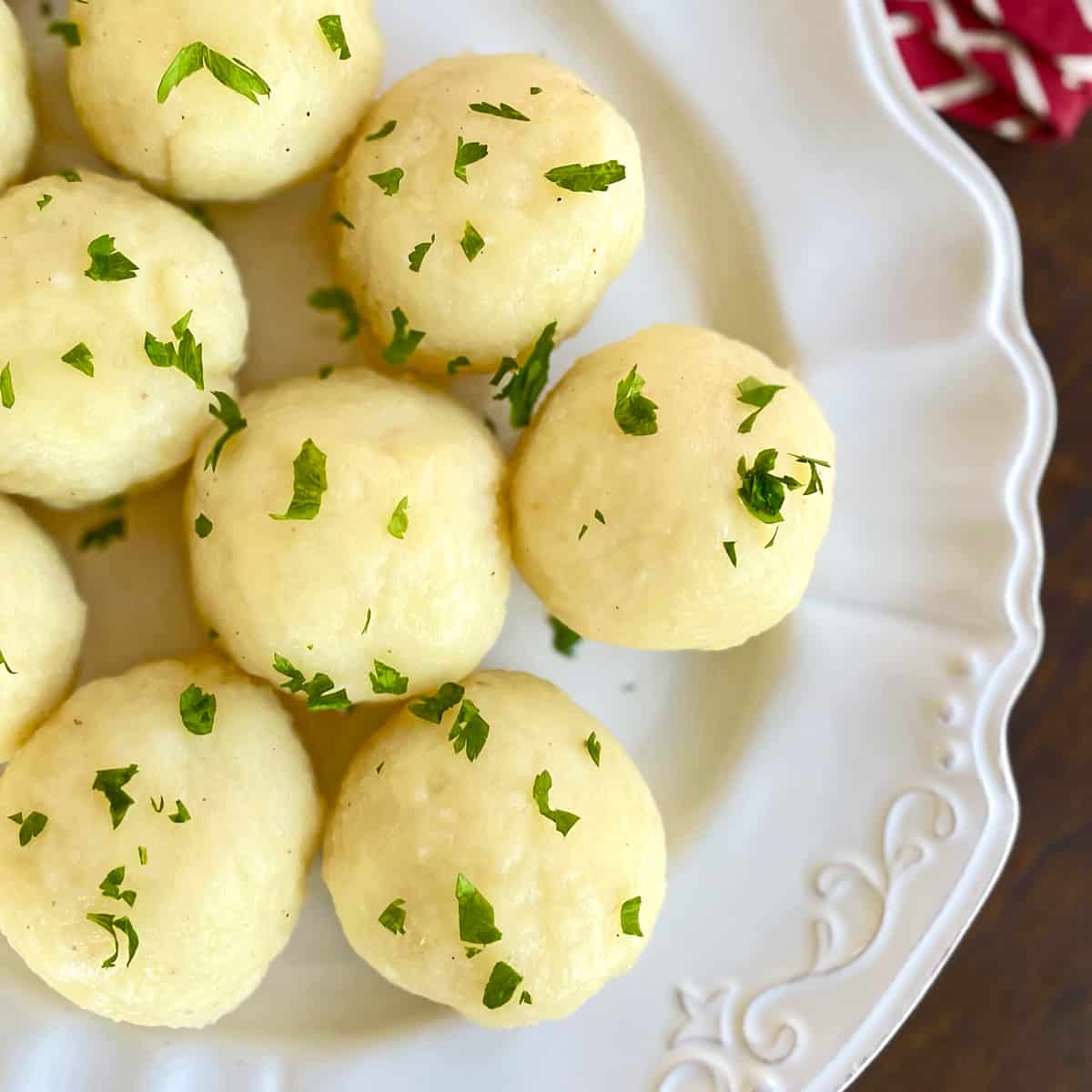
What Are German Potato Dumplings?
Potato dumplings can be found in various forms throughout the world, everything from Gnocchi in Italy and Kluski Śląskie in Poland, to Bramborové Knedlíky in the Czech Republic and Cepelinai in Lithuania. But however they may different from one country to the next, most potato dumplings are meant to be served with a sauce as the primary starch in a meal. With their tender texture and capacity for mopping up juices, they are so perfectly suited for this role. Today I’m sharing Germany’s famous potato dumpling recipe with you, called Kartoffelklöße or Kartoffelknödel (depending on the region), made the way my Mutti and Oma made them. Made from cooked riced potatoes, eggs, potato starch, and salt and formed into balls that are gently boiled, these dumplings are soft and tender and make the perfect accompaniment to your meat-and-gravy dishes or vegetarian sauce-based dishes.
There are different variations of Kartoffelklöße within Germany as well. For example, in Franken half of the potato content is raw shredded potato that’s mixed in with the cooked riced potato (known as “halb und halb”, or half and half). In Thüringen the ratio of raw potato is even higher. The more raw potato content, the firmer/denser the finished dumpling is; the more cooked potato content, the softer and fluffier the dumpling is. Which variation you choose is simply a matter of personal preference. My mom prefers the Thüringer Kartoffelklöße (she also spent part of her childhood in Thüringen before moving to Stuttgart); I love both but slightly prefer the all-cooked potato version that I’m sharing with you today.
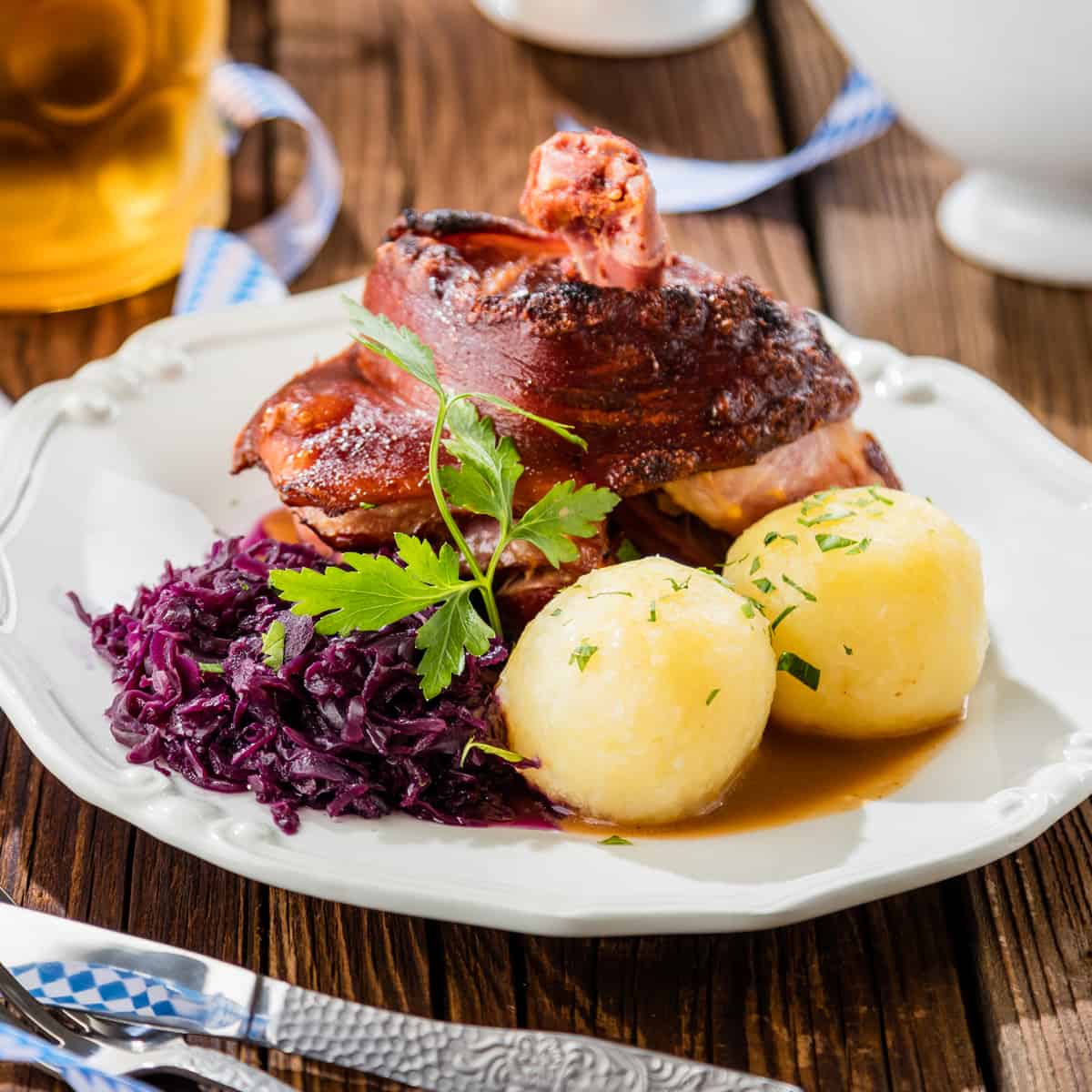
Pro Tips for Making Kartoffelklöße
German potato dumplings are not hard to make, but there are a few things that will either make or break their outcome. If you follow these tips, you’re virtually guaranteed success:
- Choose potatoes that are high in starch and low in moisture. These will produce those wonderfully pillow-soft and tender dumplings. Russet potatoes are best. (In Germany look for “mehlig kochende” varieties). Waxy, higher moisture potatoes like Yukon Golds will produce a denser, heavier texture.
- You MUST use a potato ricer. It makes ALL the difference in the texture. If you try using mashed potatoes you’ll end up with dense, stodgy potato dumplings.
- Use potato starch, not wheat flour. Regular flour will give them a dense and stodgy texture. Make sure it’s potato starch and not cornstarch.
- Do not let the water boil too vigorously at any point once the potato dumplings are in the water; keep it to a low boil/simmer.
- Be sure to let them cook in the simmering water for the full 20 minutes.
If you make your own Spaetzle and already have this type of Spaetzle maker, that will double as a potato ricer and there’s no need to buy a different one. You can also use a food mill if you have already have one. If you need to buy a potato ricer there are both stainless steel and hard plastic options. I have and use the RSVP potato ricer. It’s very sturdily built, comfortable to press with your hands, performs the job well, and is dishwasher safe. It also comes with two interchangeable medium and coarse plates.
If you’re a bargain hunter like me, food mills and potato ricers are both things you can often find at your local thrift stores and charity shops.
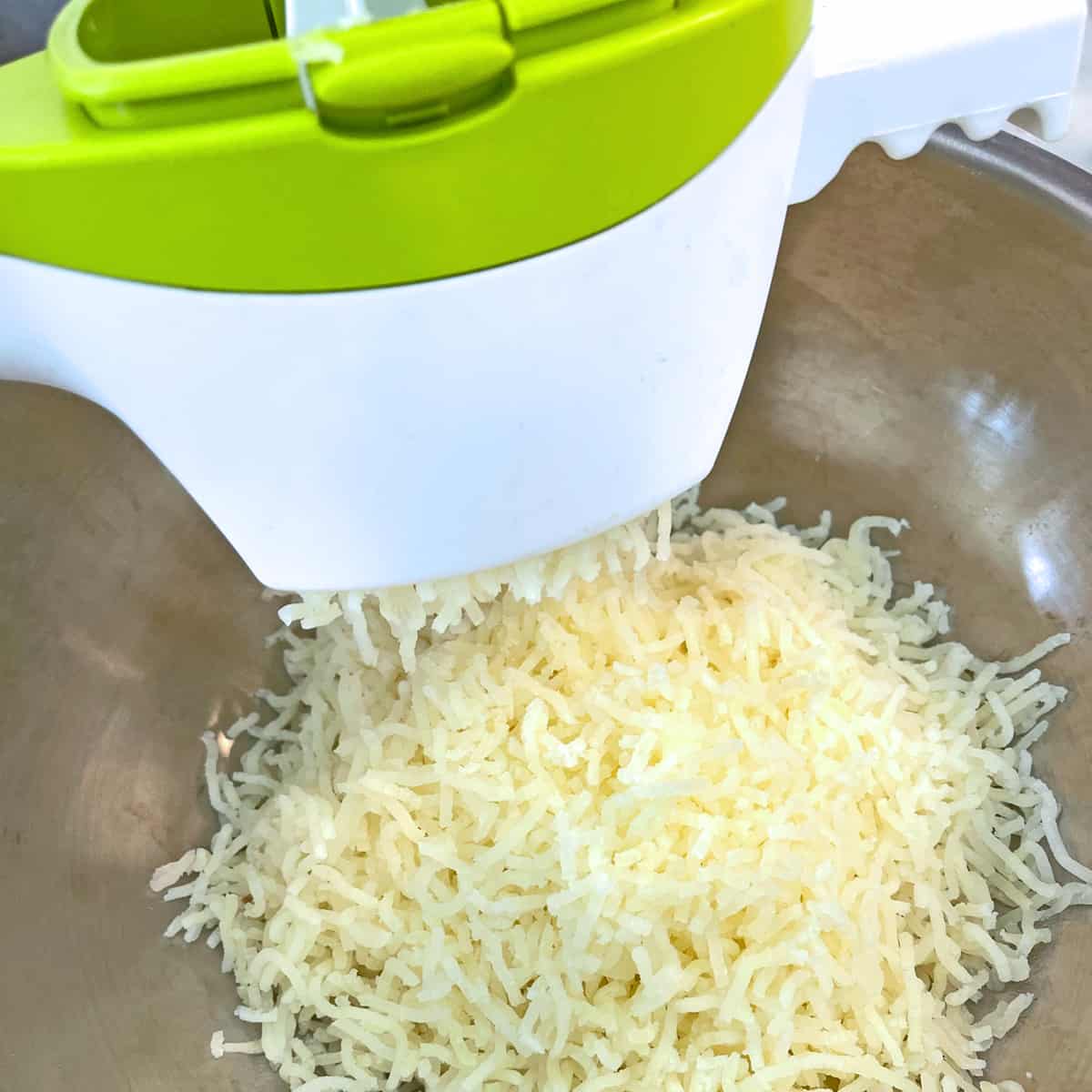
With your food mill or potato ricer in hand along with just a handful of ingredients, you’re ready to make the very best German potato dumplings you’ve ever had!
And be sure to check out the bottom of this blog post for serving recommendations for more favorite German recipes and beyond!

German Potato Dumplings Recipe
Let’s get started!
Note on the Croutons: Some regions of Germany like to include bread croutons in the center of their potato dumplings. I’d say most do not. But including them does “lighten” the overall texture. I’m including instructions for it to give you the option.
To prepare the croutons (this filling is optional, you can skip this step if desired): Heat a non-stick skillet over medium heat and melt the butter in it. Add the bread cubes and fry until golden brown on all sides. Transfer to a bowl and set aside until ready to use.
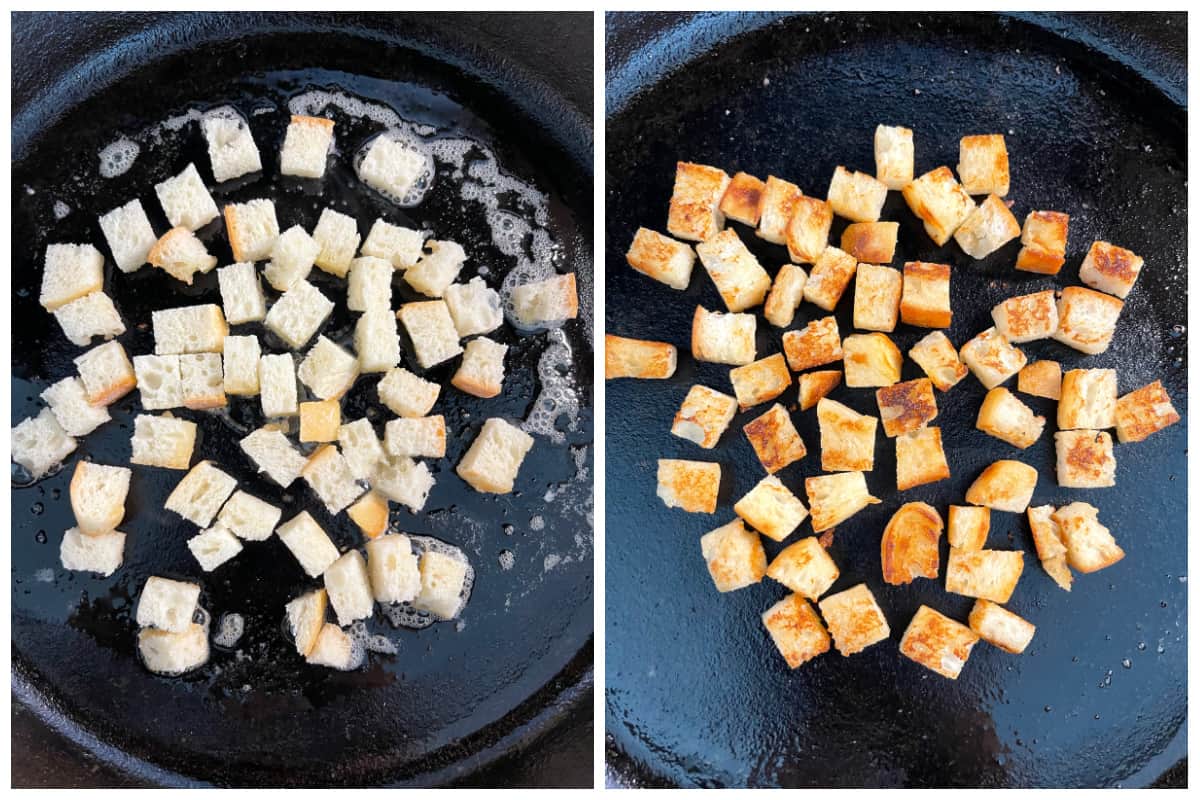
Boil the potatoes whole, skins on, in lightly salted water until tender.
Drain and let sit until they’re cool enough to handle but still warm and then peel them.
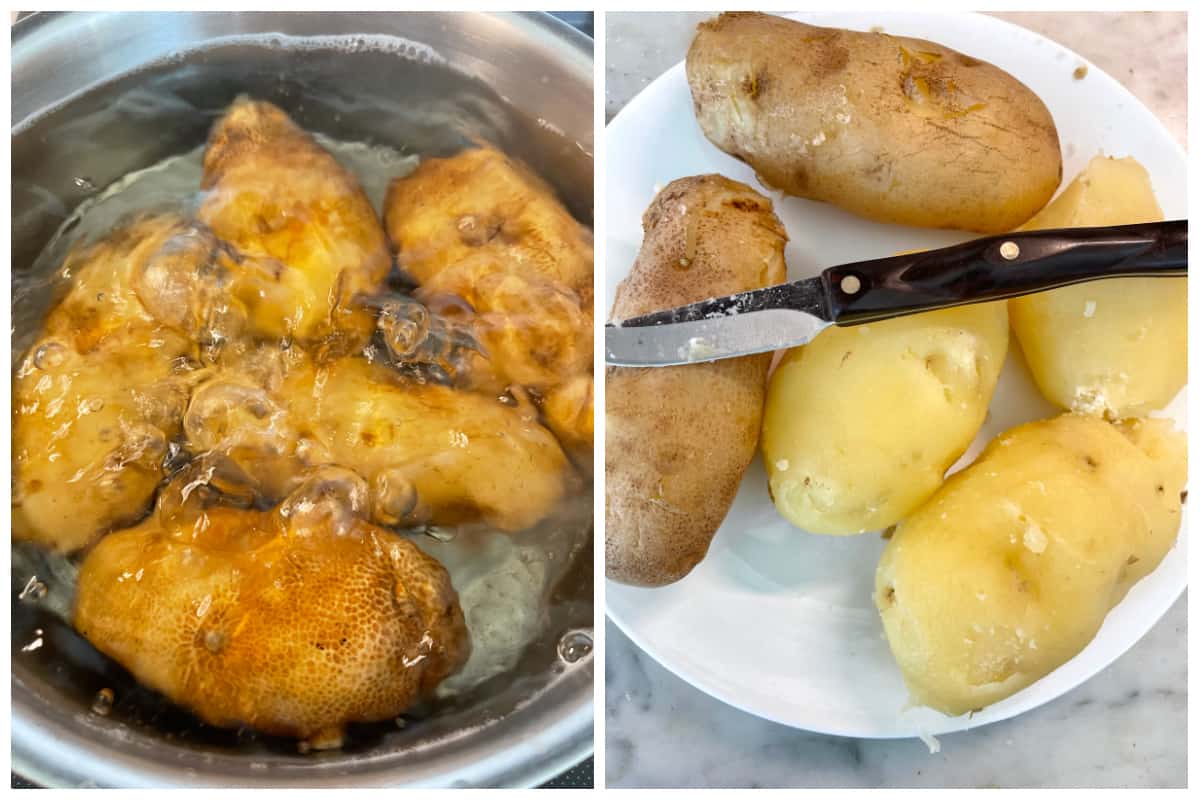
Run the potatoes through a food mill or potato ricer (two options include stainless steel or dishwasher safe hard plastic) into a large bowl. (Ricing the potatoes is imperative for achieving the right texture as mashing them will produce dense, stodgy gnocchi.)
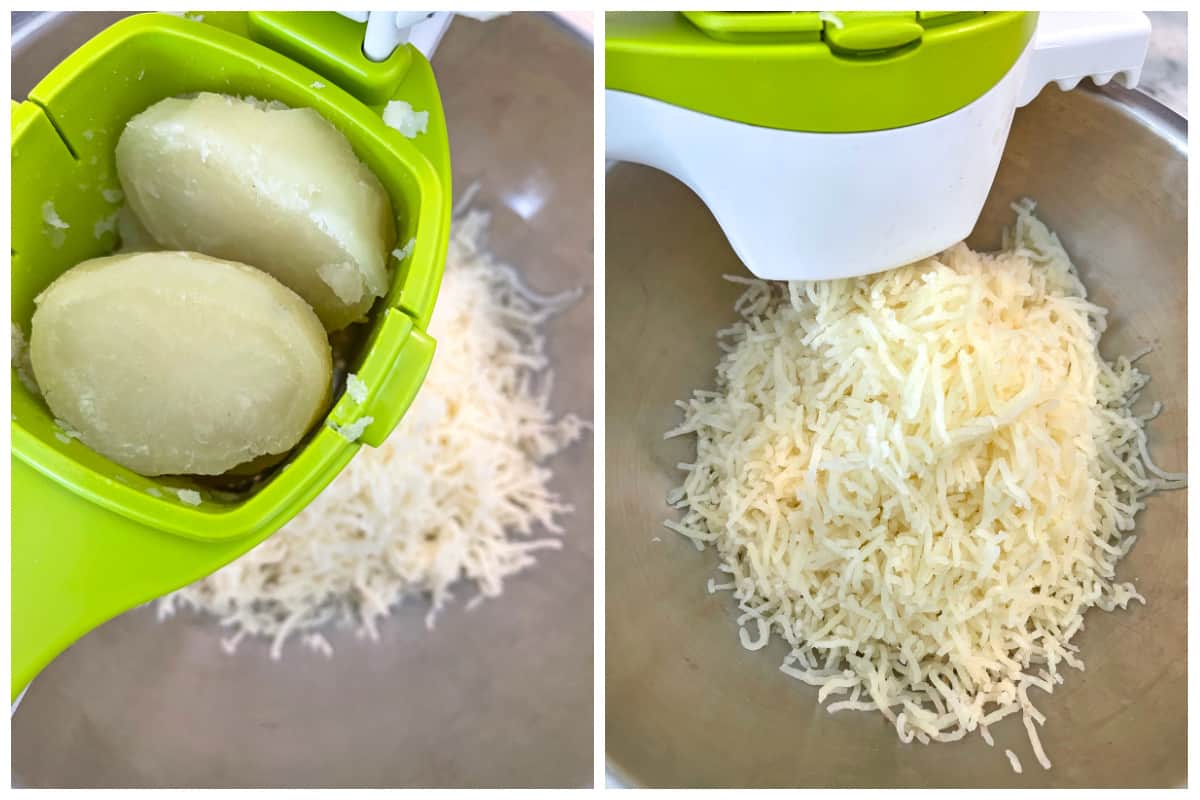
Add the potato starch, salt, egg and nutmeg to the riced potatoes.
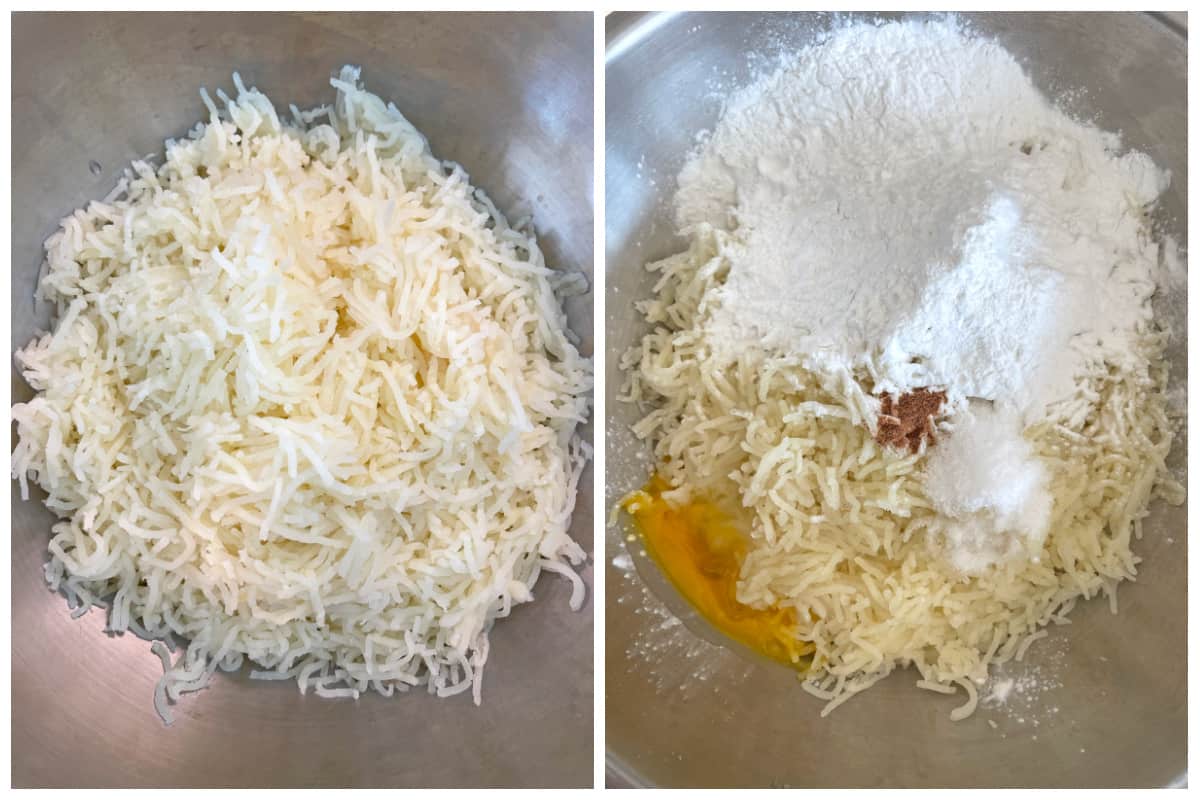
Use your hands to knead the mixture into a smooth, soft dough, being careful not to over-mix.
The dough should nice and soft but not sticky. If it is, add a little more potato starch.
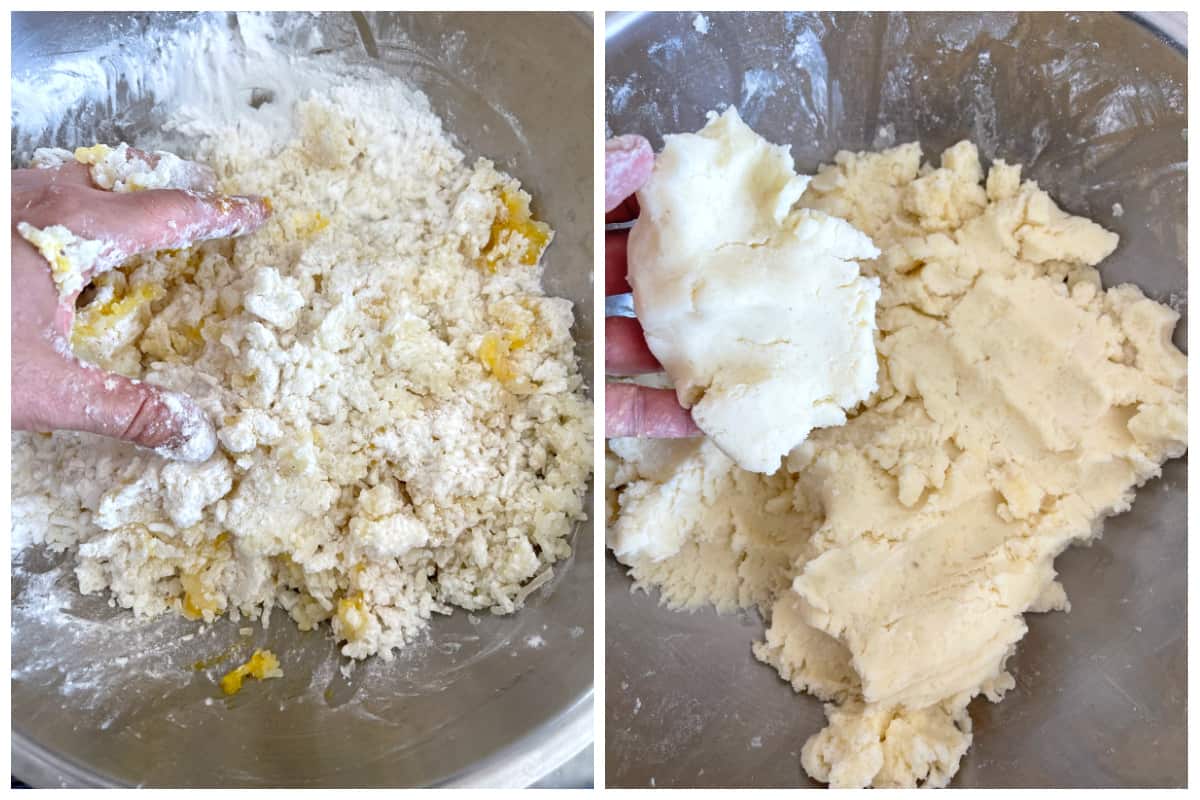
Form the mixture into twelve 2 1/2 inch diameter balls.
I like to weigh them to get them uniform in size. They should each weight roughly 90 grams.
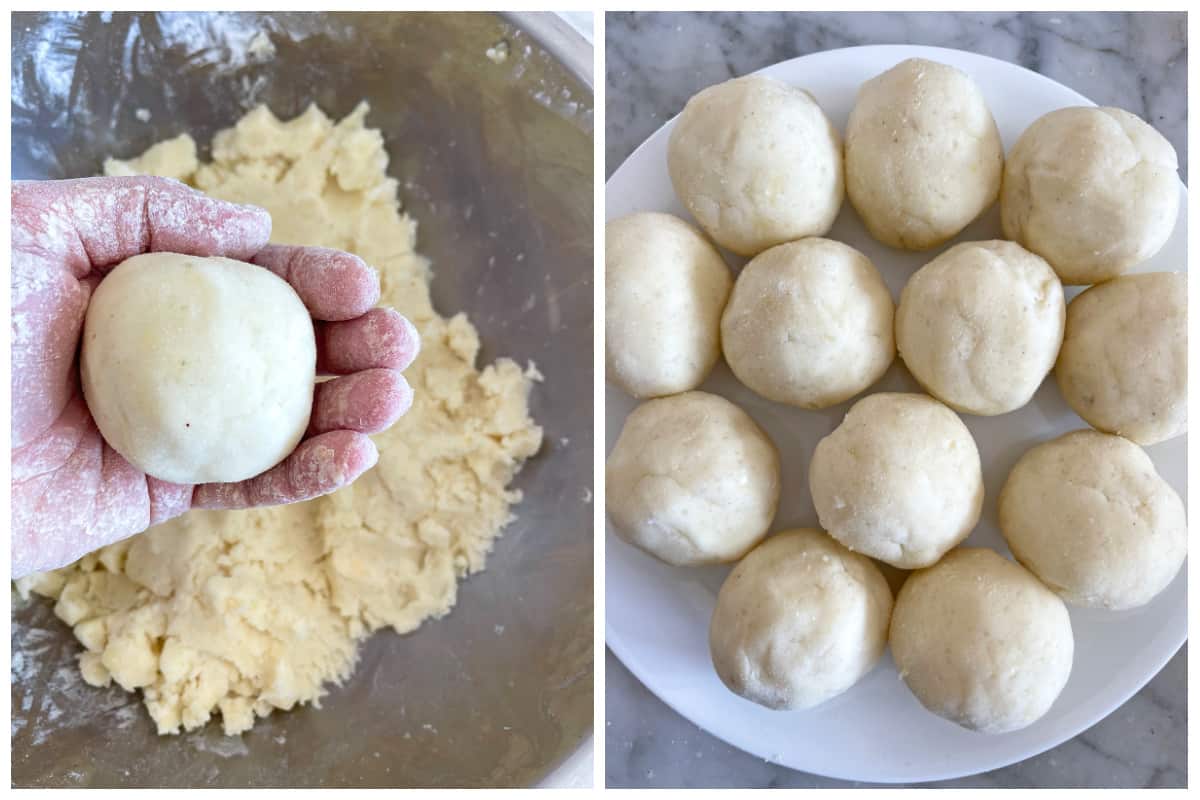
Optional crouton filling:
You can fill your potato dumplings with croutons or skip this step and go straight to cooking them.
If you’re adding the croutons, use your thumb to press a deep indentation into each ball. Depending on the size of your croutons, place 2-3 croutons in each indentation and then close them up and roll them back into balls.
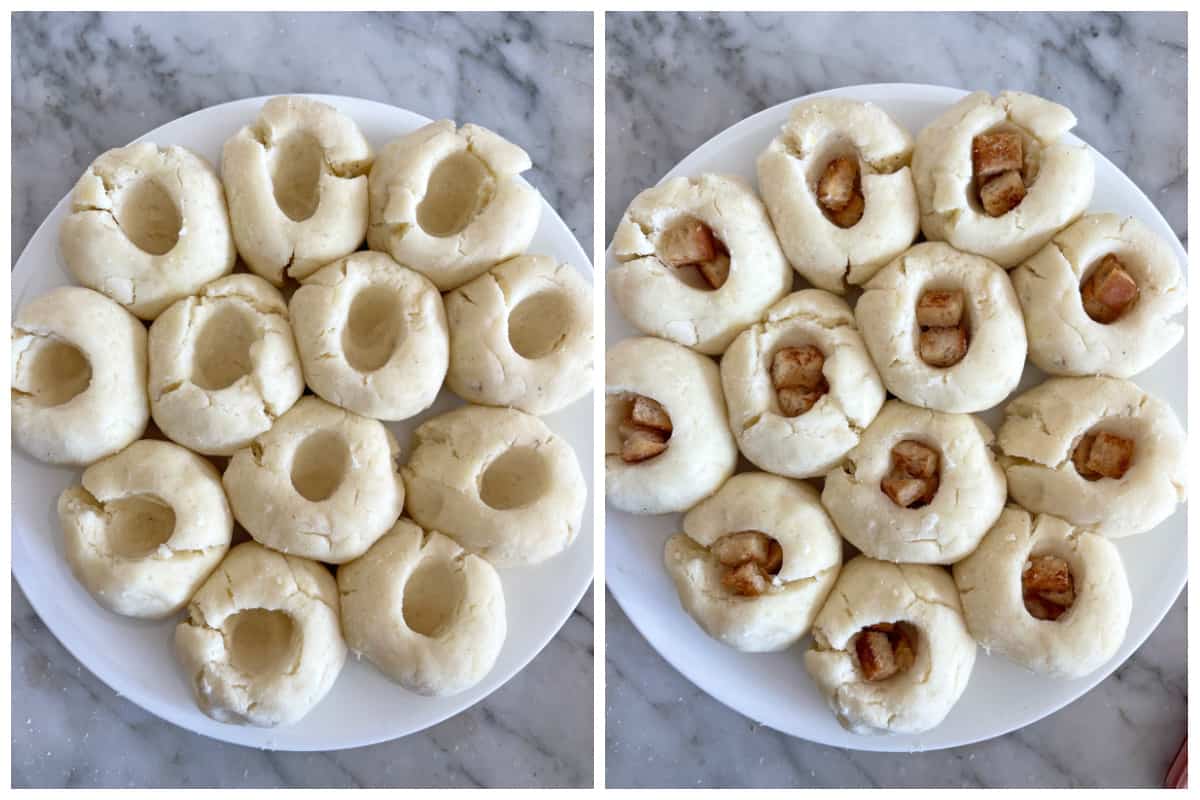
Bring lightly salted water to a rapid boil in a large pot (all twelve dumplings fit perfectly without overcrowding in my 11 inch diameter pot).
Reduce the heat. Gently lower the dumplings on a spoon into the water, holding them for a few seconds before releasing them (this will prevent them from sticking to the bottom).
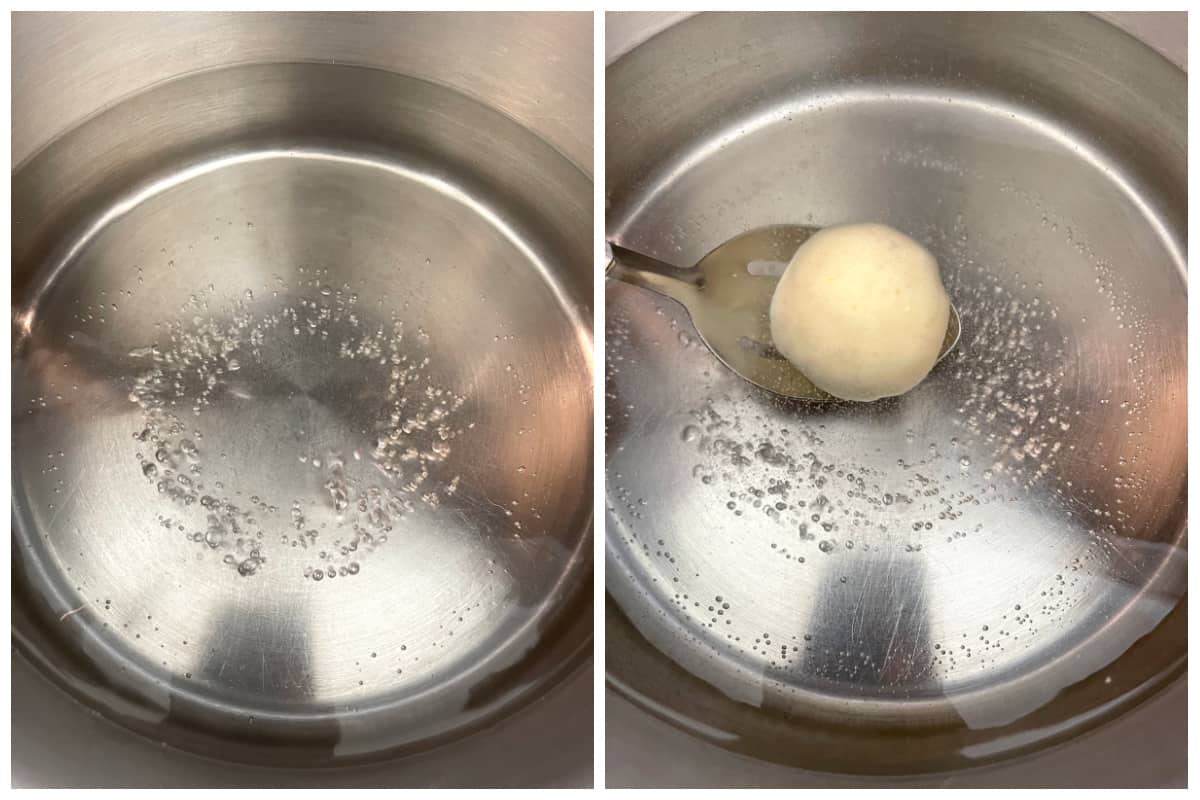
Adjust the heat so that the water stays at a gentle simmer. Let the Kartoffelklöße simmer for 20 minutes, uncovered. Within a few minutes the dumplings will all rise to the top; let them continue to simmer for the full 20 minutes.
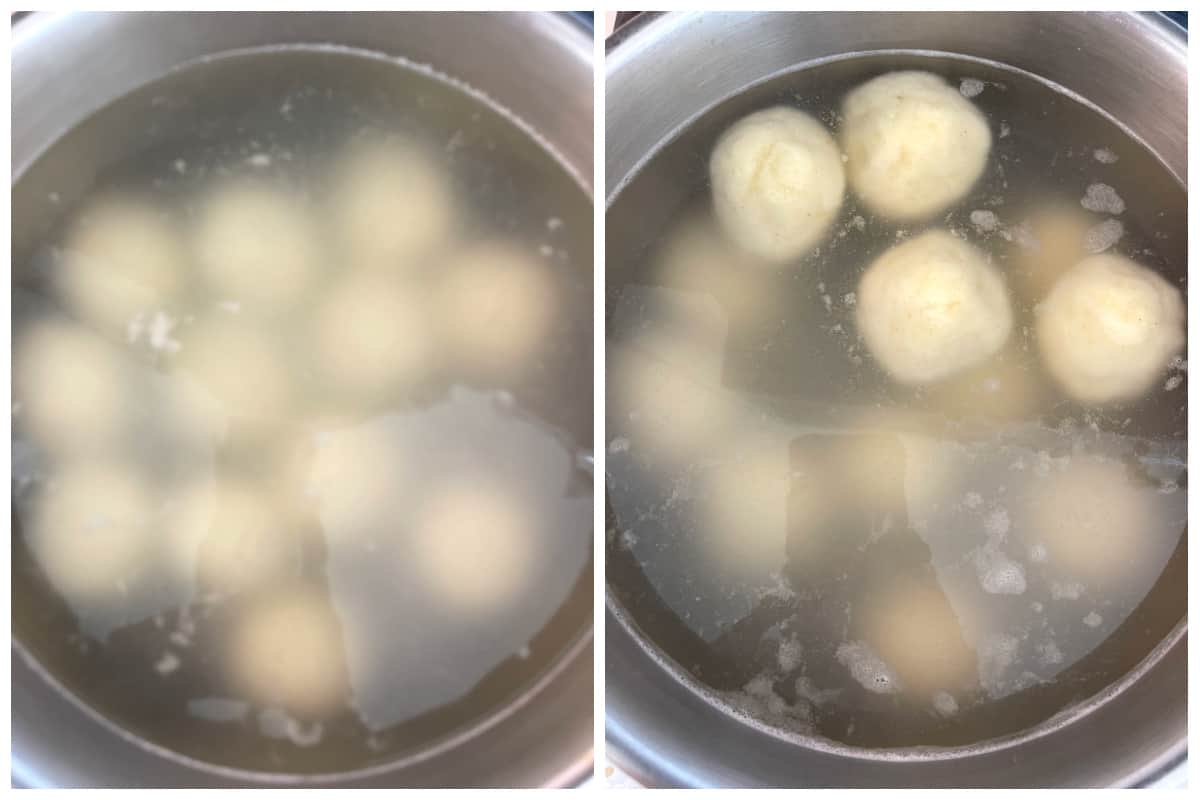
Once they’re done, turn off the heat. They can be kept warm in the water for up to 15 minutes while you’re finishing up dinner. If you need more time they can be kept in the drained warm pot or transferred to a warm bowl and covered to keep the warmth in.
Arrange the German potato dumplings on a warm serving plate garnished with some chopped parsley.
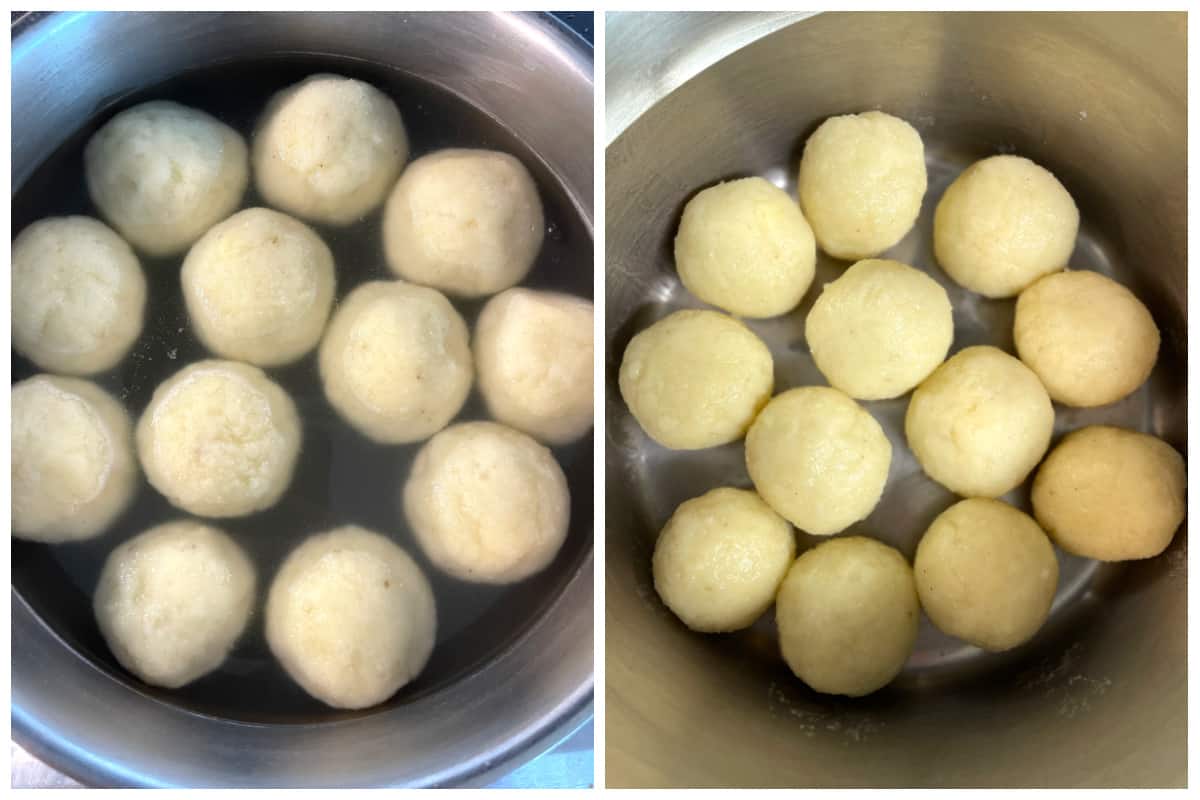
Can You Freeze German Potato Dumplings?
Yes, you can freeze cooked potato dumplings. Freeze them on a baking tray and then transfer them to a freezer container where they will keep for up to one month. Simply reheat the Kartoffelklöße in a covered container in the microwave so they don’t dry out or you can reheat in very gently simmering (not boiling) water on the stovetop. If you want to make potato dumplings in advance but don’t want to freeze them, they will keep in the fridge for up to 3 days. That said, Kartoffelklöße are best eaten the same day as their texture and flavor will deteriorate thereafter. Many Germans use up leftover Kartoffelklöße by slicing then and frying them in butter.
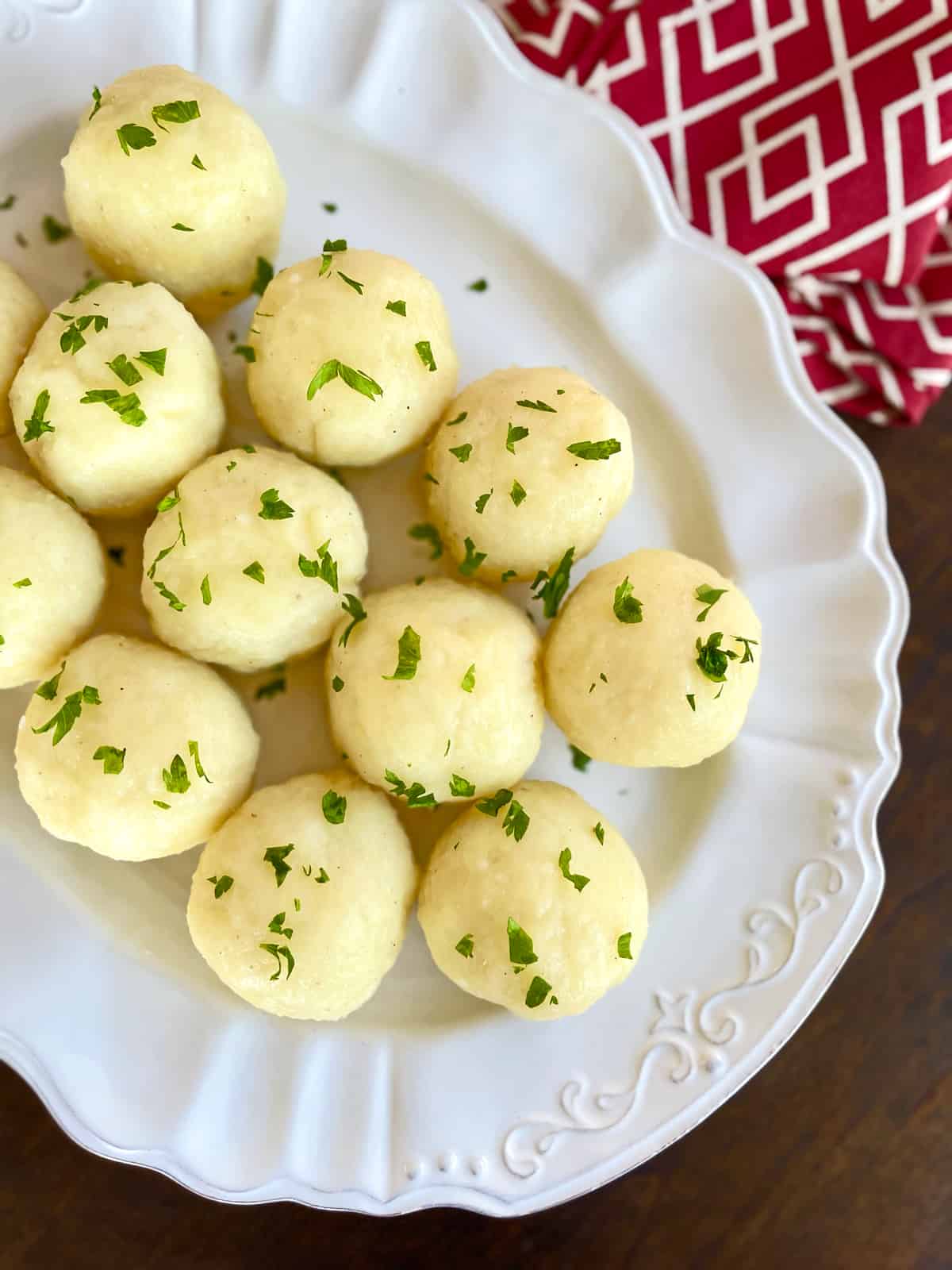
What to Serve With German Potato Dumplings
Kartoffelklöße, or German potato dumplings, are served as a side dish to accompany various main courses, especially sauce-based dishes, meat dishes in particular, though they pair beautifully with any number of sauce-based vegetarian options as well. Here are some common dishes and accompaniments you can serve with Kartoffelklöße:
- Roast Meats like a beef roast, Pot Roast, Tri Tip Roast, or pork roast such as Senfbraten (German pork roasted with mustard gravy). Also roast game, roast poultry, and Schweinshaxe.
- Sauerbraten
- Jägerschnitzel
- Königsberger Klopse
- Bratwurst or other Sausages
- German Goulash, Hungarian Goulash, Szegedin Goulash or Pörkölt.
- Rouladen
- Geschnetzeltes or Zurich Ragout
- Gravies and Sauces such as Mushroom Gravy, Onion Gravy, Turkey Gravy, Rahm Sauce and Hungarian Mushroom Sauce.
- German Red Cabbage (Rotkohl): This is the classic vegetable dish to accompany your Kartoffelklösse if you’re serving them with beef as the protein.
- Sauerkraut: This is the classic vegetable dish to accompany your Kartoffelklöße if you’re serving them with pork as the protein.
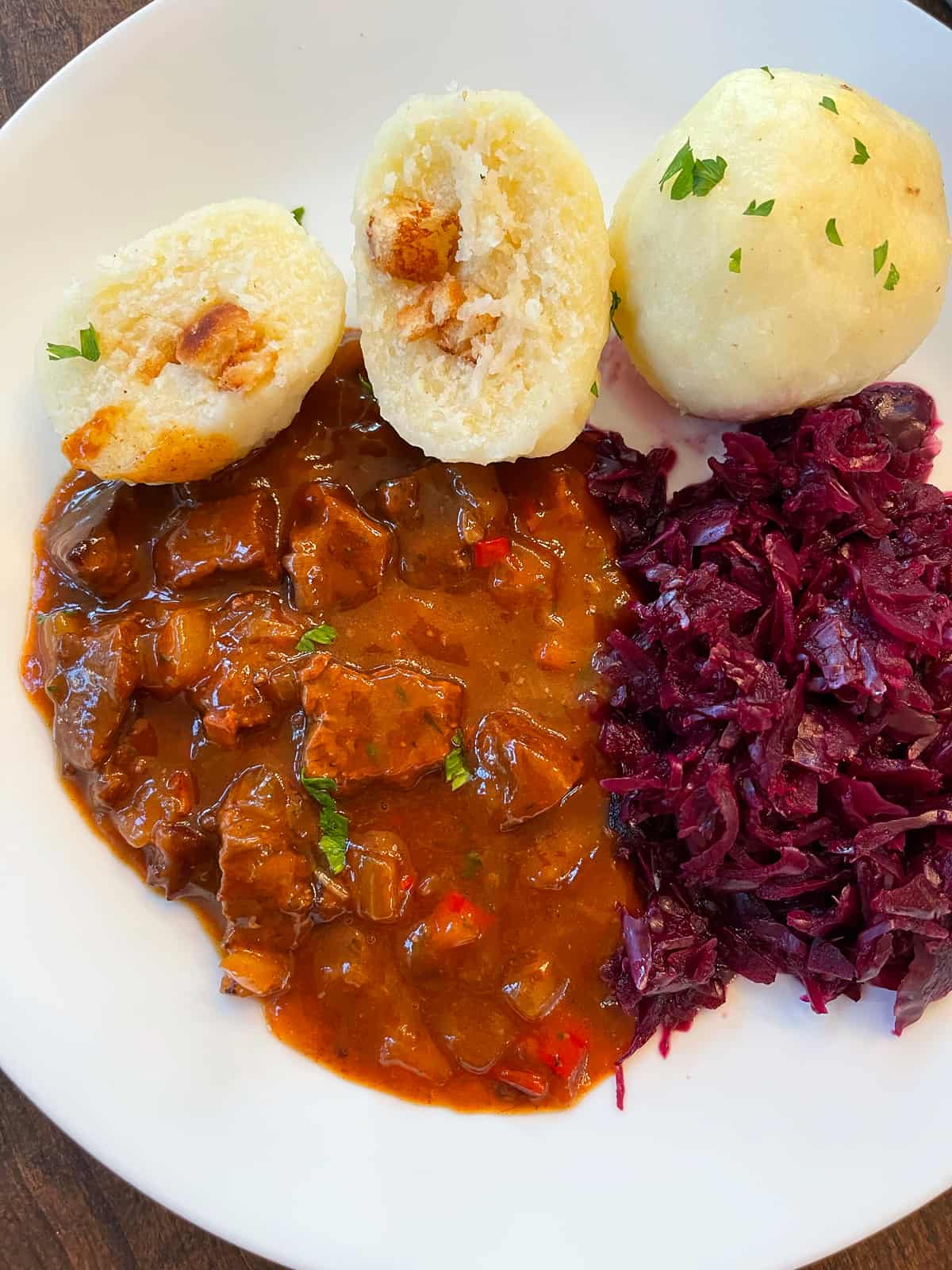
For more dumpling recipes be sure to also try my traditional:
- Semmelknödel (German Bread Dumplings)
- Dampfnudel (German Steamed Dumplings)
- Germknödel (Austrian Yeast Dumplings)
- Potato Gnocchi
- Spaetzle
Save This Recipe
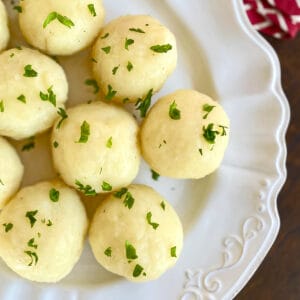
Kartoffelklöße (German Potato Dumplings)
Ingredients
- 2 1/4 pounds Russet potatoes , high starch/low moisture potatoes will produce the most tender results (in Germany look for "mehlig kochende" varieties),
- 1 large egg
- 1 cup potato starch
- 1 1/2 teaspoons salt
- 1/8 teaspoon ground nutmeg
- For the Croutons (optional):
- 1 large slice sourdough bread , cut into very small cubes
- 2 tablespoons butter
- chopped fresh parsley for serving
Instructions
- To prepare the croutons (this filling is optional, you can skip this step if desired): Heat a non-stick skillet over medium heat and melt the butter in it. Add the bread cubes and fry until golden brown on all sides. Transfer to a bowl and set aside until ready to use.
- Boil the potatoes whole, skins on, in lightly salted water until tender. Drain and let sit until they're cool enough to handle but still warm and then peel them. Run the potatoes through a food mill or potato ricer (two options include stainless steel or dishwasher safe hard plastic) into a large bowl. (Ricing the potatoes is imperative for achieving the right texture as mashing them will produce dense, stodgy gnocchi.)
- Add the potato starch, salt, egg and nutmeg to the riced potatoes. Use your hands to knead the mixture into a smooth, soft dough, being careful not to over-mix. The dough should nice and soft but not sticky. If it is, add a little more potato starch. Form the mixture into twelve 2 1/2 inch diameter balls (roughly 90 grams each, you can weigh them to get uniform sizes). If you're adding the croutons, use your thumb to press a deep indentation into each ball. Depending on the size of your croutons, place 2-3 croutons in each indentation and then close them up and roll them back into balls.
- Bring lightly salted water to a rapid boil in a large pot (all twelve dumplings fit perfectly without overcrowding in my 11 inch diameter pot). Reduce the heat. Gently lower the dumplings on a spoon into the water, holding them for a few seconds before releasing them (this will prevent them from sticking to the bottom). Adjust the heat so that the water stays at a gentle simmer. Let the Kartoffelklösse simmer for 20 minutes, uncovered. Within a few minutes the dumplings will all rise to the top; let them continue to simmer for the full 20 minutes. Once they're done, turn off the heat. They can be kept warm in the water for up to 15 minutes while you're finishing up dinner. If you need more time they can be kept in the drained warm pot or also be transferred to a warm bowl and covered to keep the warmth in. Makes 12 potato dumplings.
Video
Nutrition
Originally published on The Daring Gourmet October 26, 2023



















Love, love this recipe and can’t get enough! I’ve made it a few times now (many more to come) for my boyfriend who used to live in Germany. He can’t have eggs, and after a couple experiments I got amazing results by simmering 2tbsp tapioca starch with 3tbsp water until sticky and then using that as an egg sub.
Curious—have you ever shaped these the day before boiling them and left them raw in the fridge overnight?
Fantastic! I’m thrilled that these have become a regular and appreciate the feedback about the egg-free substitution. I haven’t tried shaping these a day in advance but I don’t see why that wouldn’t work. Please let us know how it goes if you try that!
So happy I found this recipe and can’t wait to try it. Can I use the kitchen aid meat grinder instead of a potato ricer? The only other thing o can find is a masher.
You sure can, Lisa! If the meat grinder comes with different plate sizes (hole sizes), use the smaller one. Happy cooking!
Absolutely loved these for decades! Oma made them as our annual New Year’s Day meal of sauerbraten and red cabbage. We ‘riced’ our potatoes in a cast iron food grinder that was clamped to the end of our table in those days. We often had extras that we would fry in butter for the leftovers! Heaven!
Thank you for sharing those memories, Judi. Yes, my Mutti and Oma would likewise fry up the leftovers in butter – so good!
Memories!! I love these so much. We always had them with sauerbraten and red cabbage as our annual New Year’s Day meal!